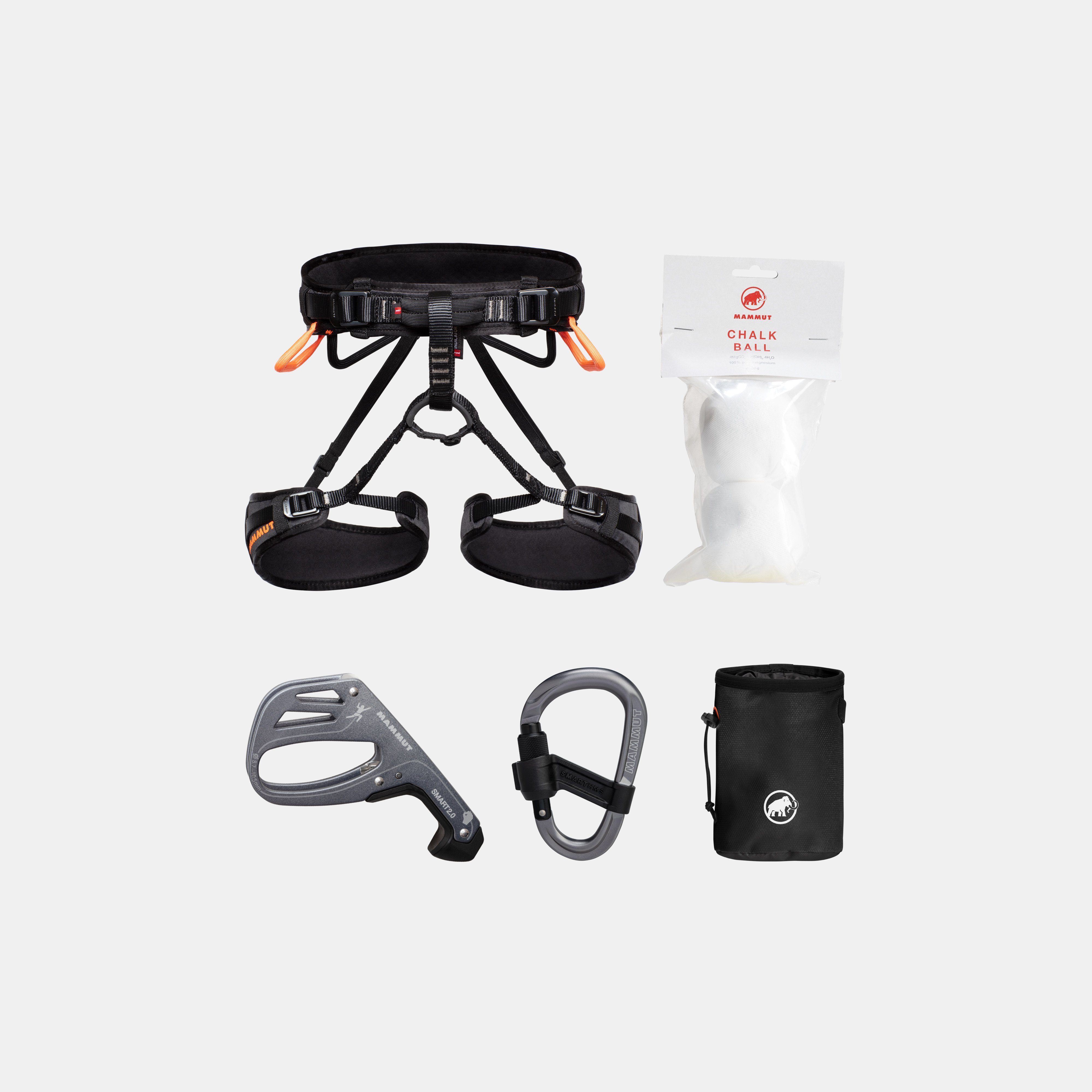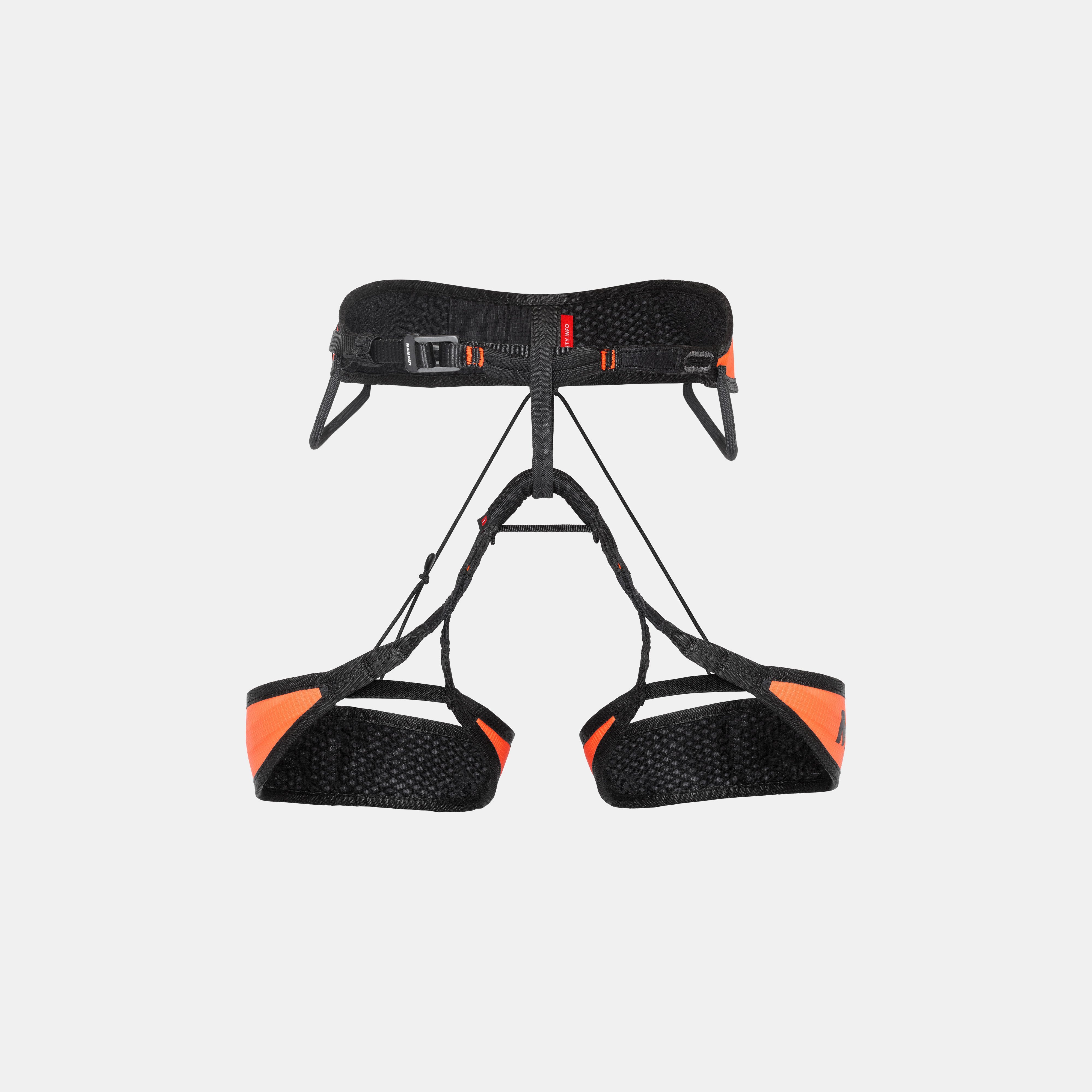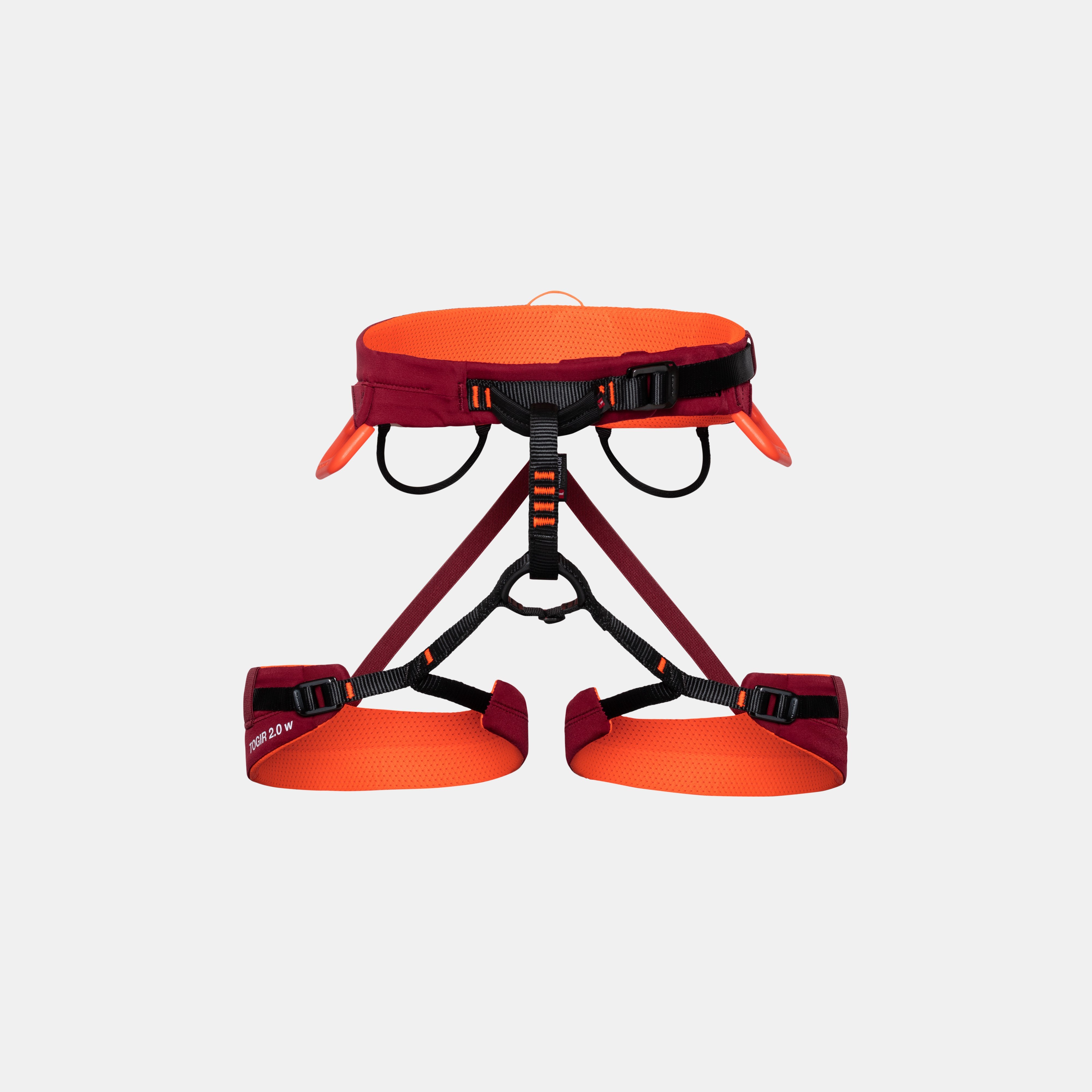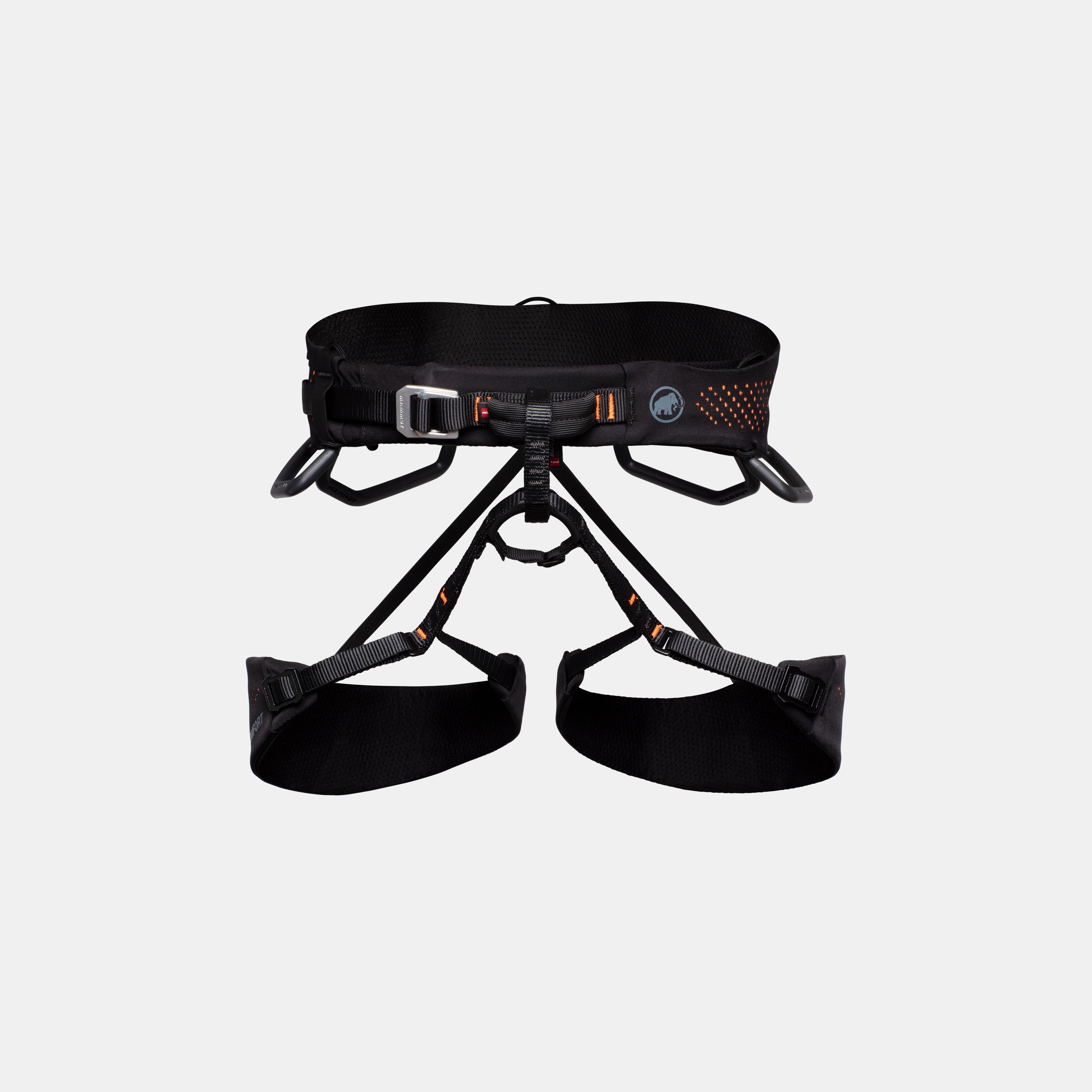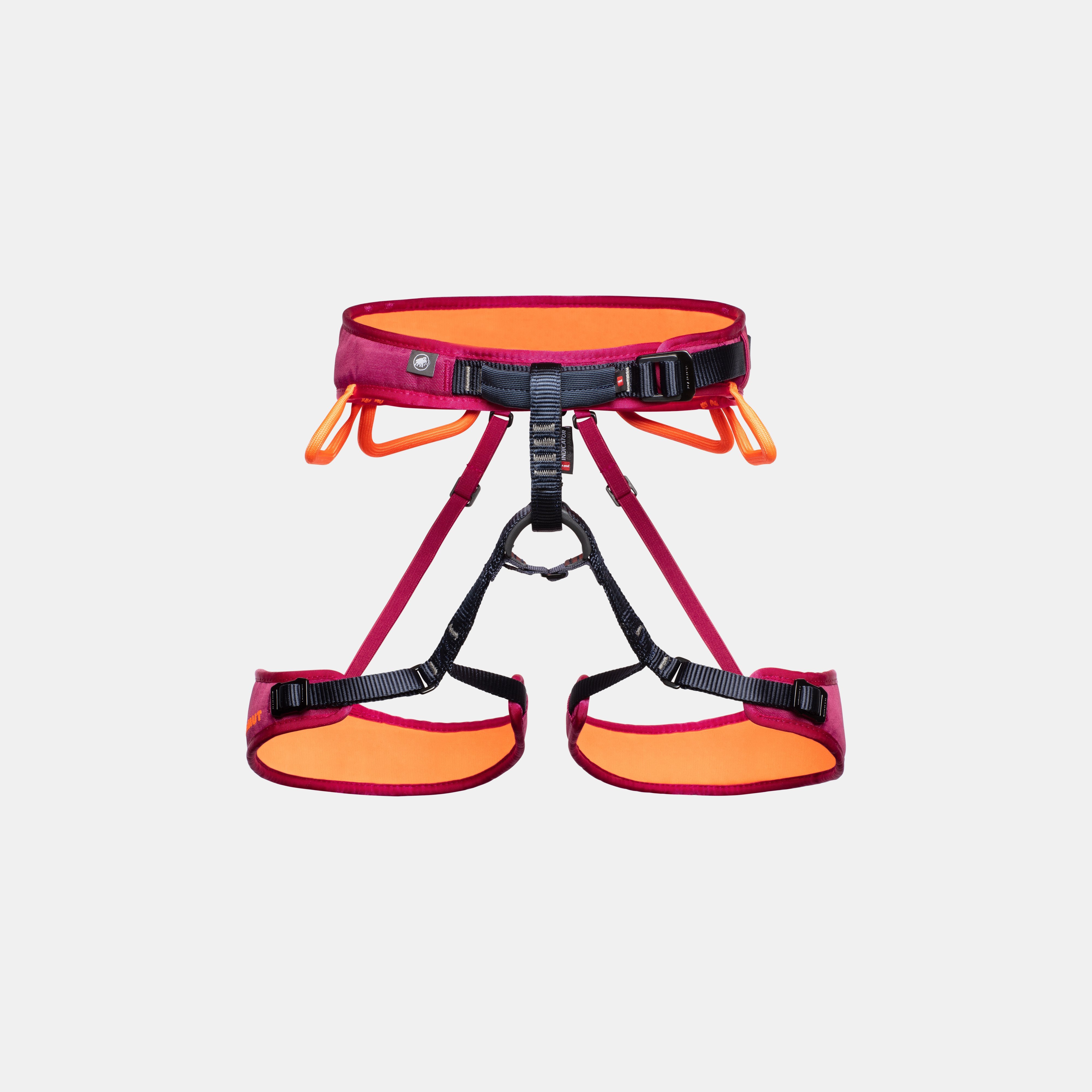Climbing Harness: How to find the right size & fit
04/2024

If free soloing isn’t your thing and you prefer to err on the side of caution, there’s just no way around a climbing harness that fits you like a T. When you’re scaling those rocky walls, a properly fitting harness will not only keep you safe, but ensure that you’re sitting pretty and comfortable on your way to mountaineering glory. Find out what to look out for when buying a climbing harness – and sit back.
To make your search for the perfect climbing harness as easy as possible, we’ve put together a quick overview of the key things to watch out for:
Fit: The harness should fit comfortably, but still be tight enough so you can safely carry out all your moves, without restricting your freedom of movement.
Adjustability: You shouldn’t mold yourself around your harness, but your harness around you! Adjustable loops are a standard feature and provide comfort – regardless of your body type.
Cushioning: When you’re struggling to get past the crux of your route and need more time to complete all your moves, breathable materials and soft cushioning will keep you comfortable while you hang in there.
Number of gear loops: When conquering big rocks, where every carabiner , nut and more count, you’ll need every gear loop you can get your hands on. For dynamic sport climbing, a limited number of loops will be perfectly sufficient.
Weight and packsize: When you’re on a long and strenuous tour, every extra gram quickly feels like a ton of added weight. Try to find a good compromise between lightness and convenient extra features.
Certifications: When it’s all about your safety, you shouldn’t leave anything to chance. That’s why all our Mammut harnesses are fully compliant with the standards set out by the International Climbing and Mountaineering Federation (UIAA).
Anatomy of a climbing harness
Before jumping head-first into picking out a climbing harness, you should take the time to get familiar with its components and their purpose. This will make it easier to weigh up the pros and cons of a specific harness in line with your individual needs, and find the fit that’s 100 % right for you. Generally, a climbing harness consists of the following parts:
Hip strap: The hip strap winds around the waist and sits above the pelvis. Its width varies depending on the type of harness. Hip straps usually have cushioning to provide extra wearing comfort, which is particularly handy when you’re on a longer tour. Straps without cushioning, on the other hand, are lighter, which makes them a much better choice for alpine climbing. The Mammut Zephir and Togir lines use our unique split webbing technology, making our harnesses super lightweight while ensuring great freedom of movement and an extra comfortable seat. Our tried and tested two-part webbing technology ensures optimum pressure distribution via a supporting band and comes with every climbing harness from our Ophir line
Hip buckle: Climbing harnesses come with either one or two buckles to allow for quick adjustment of the hip strap, making it easy to quickly fit your harness to your individual waist measurements, and center it. Double buckles make it easier to adjust your harness, but also add a little bit of extra weight. Slide bloc buckles are easy to handle, and will keep you doubly safe. Fast-adjust and click buckles make taking your harness on or off especially quick and easy. Also watch out for features that allow you to tuck in the ends of the straps to keep them out of the way when climbing.
Gear loops: These are fitted on the sides of the waistband and allow you to attach your Chalk Bag, quickdraws , belay devices and other climbing gear. There are two different types of gear loops. Loose gear loops are made for secondary equipment, while stiff, molded gear loops allow for extra quick access to your essential gear. Climbing harnesses can have different numbers of gear loops in various different sizes, so think about how many you’re most likely going to need.
Leg loops: The leg loops wrap around your thighs and should sit just below the rear. The same rules apply: More cushioning means extra comfort, less cushioning makes for less weight. Many climbing harnesses are fitted with buckles and click buckles so you can easily adjust the leg loop – particularly handy when you need to put your harness on or take it off while wearing crampons or skis. Leg loops without buckles will help you reduce weight. If you’re already wearing your leg loops on your way to your starting location, wide and hard leg loop cushioning may obstruct you while walking. Conversely, extra thin or soft loops aren’t particularly comfortable when you’re taking longer breaks suspended in the air.
Tie-in loops & safety loops: Tie-in loops around the waist and legs allow you to attach your climbing rope , depending on your chosen belaying technique. Especially when mountaineering, the tie-in point should be as high up as possible so you don’t accidentally step on the rope while you’re suspended. The safety loop connects both tie-in loops with each other, as well as the leg loops with the waist strap. It’s the most resilient and hardwearing part of any harness, and the point where you attach carabiner and belay device . The tie-in loops on most of our Mammut climbing harnesses are equipped with a special indicator in the tie-in loop that tells you when it’s time to replace your harness.
Elastic straps: Both leg loops are attached to the back of the waist strap with elastic straps. These are often adjustable in length, making it easy to get the fit of your leg loops exactly right. Many of our Mammut climbing harnesses come with drop-seat buckles which allow you to detach the elastic bands from the hip strap – a particularly handy feature when nature’s calling while you’re out climbing.

1 Waist Buckle
2 Gear Loops
3 Safety Loop
4 Elastic Straps
5 Leg Buckle
6 Waist Belt
7 Tie-in Loops
8 Leg Loops
How should a climbing harness fit?
Even the most advanced climbing harness won’t live up to its full potential when it doesn’t hug your body right. That’s why it’s so important to think about the right size and fit first. Most importantly, the hip strap has to fit properly and sit above the hip (roughly at about the navel), while leg loops should be neither too tight nor too loose. If your freedom of movement is limited, the fun will be sucked out of your climbing experience too. From hip strap to belt strap and hip buckle, make sure to leave enough space so you can comfortably and freely move, and still wear a jacket underneath your harness if needed.
As a general rule: The more buckles your climbing harness is equipped with, the easier it is to adjust it to perfectly fit your body. This comes in particularly handy when you’re wearing just one layer underneath one day, several thick layers the next, or need to take an extra layer or two off in the middle of a climbing session. The more buckles you have, the heavier the harness will be. So make sure you know all your requirements before choosing a new harness.


Climbing harnesses for women, men & kids
While most climbing harnesses are unisex, some models are designed specifically to fit the male or female form. Women's climbing harnesses are usually made to fit a shorter torso and narrower hip, men’s climbing harnesses are longer and wider. Additionally, the hip strap on women’s climbing harnesses is located higher up and the leg loops are generally wider to complement their body proportions, while men’s climbing harnesses are generally available in bigger sizes. Compared to unisex models, you’ll get a much more precise fit when choosing one that’s tailored to your anatomical shape.
There are also special climbing harnesses for our smaller, soon-to-be climbing heroes. Our Ophir kids climbing harnesses not only are considerably smaller and narrower, but also come with four buckles. This allows for quickly putting them on and taking them off. And even after a growth spurt the harness can be adjusted to the child's current size.
Tips for trying on a climbing harness
Always try on your climbing harness before making a purchase – ideally, you’d also be wearing your climbing pants , as it will help you to get an idea about wearing comfort and fit. Make sure the strap doesn’t cut into you or restricts your ability to move. There always should be a bit of wiggle room as far as the hip strap and leg loops go. To see if your hip strap is too wide, you can slightly pull down the strap while you’re wearing it – if it doesn’t slip down below the hip bone, you’re safe.
Once everything is in place, try out whether you can move easily. Squat down, stretch out one leg and swivel your hips – don't be shy, after all, the harness has to fit you snugly during every movement on your climbing adventures. If you have the opportunity, make sure you try out the harness by hanging in it or weighting it to see how it behaves under weight. Pay attention to how the pressure is distributed and whether the harness is comfortable when you are sitting in it.

The right harness for every type of climbing
The different types of climbing are as varied as the features of climbing harnesses. Whether sport climbing, ice climbing or big wall climbing – for each activity there are different demands on your climbing harness. Here you will find an overview of which harness is best suited to which climbing discipline:
Indoor and sport climbing: When it comes to gear loops and buckles, less is more: a lightweight harness with minimal padding and few gear loops supports fast, agile movements. Perfect for rapid ascents on fully equipped routes.
Multi-pitch routes: When you're out and about for several hours, both comfort and additional equipment count. A well-padded harness with even pressure distribution and adjustable leg loops adapts to every situation and layer of clothing. Also make sure there are enough gear loops for your quickdraws , slings and other gadgets.
Big wall climbing: Extensive features are particularly important for big wall climbing. Numerous gear loops, optimum pressure distribution and excellent padding support you even on multi-day ascents with a heavy pack. A haul loop on the back of the harness for attaching cords is also practical.
Ice and mixed climbing: When ice climbing, the focus is on mobility, comfortable support when hanging and sufficient gear loops. Adjustable leg loops are also an advantage so that the harness fits well even with several layers of clothing and can be put on with crampons if necessary.
Mountaineering: As you are usually not sitting in the harness, the padding of climbing harnesses for mountaineering plays a secondary role. Instead, it is important to choose a thin and light climbing harness. A high tie-in point is also an advantage so that the rope stays out of your way when climbing and cannot get tangled in the crampon.
Via ferrata: No heavy padding is necessary here. As with sport climbing, make sure you have ideal freedom of movement, as well as a low overall weight and a small pack size.
What additional climbing equipment do you need?
A climbing harness without a climbing rope is like a chalk bag without chalk. In addition to a head for heights, there are also a few other essentials for the climbing wall. From climbing shoes to climbing helmets and climbing pants – at Mammut you will find all the basic equipment needed. Carabiners , slings and quickdraws are also essential for adventures on the rock.
Do you want the same climbing equipment as a pro? Then let the Mammut athletes inspire you! Conquer the most difficult routes like Katherine Choong , adapt to the rock like Adam Ondra and develop willpower and endurance like Amruta Wyssmann . Your climbing gear is always at your side.
